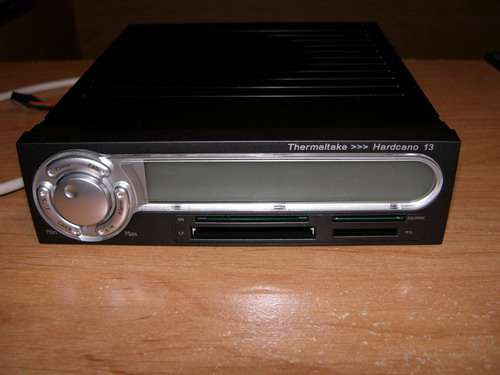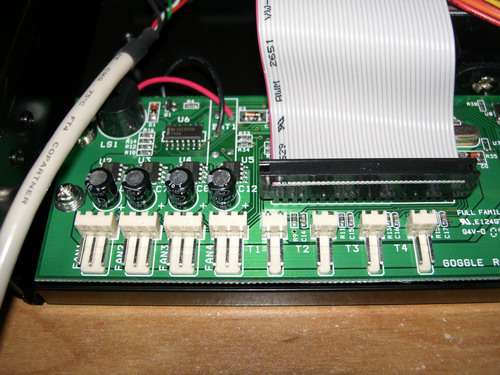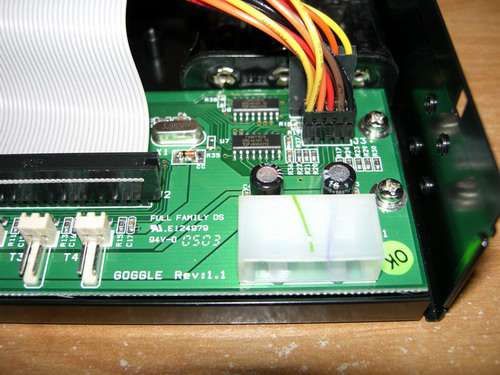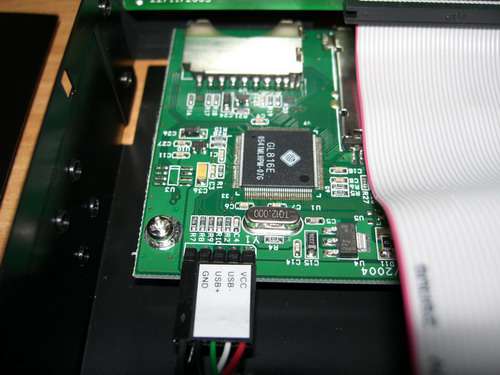- Qualcomm Launches Snapdragon 4 Gen 2 Mobile Platform
- AMD Launches Ryzen PRO 7000 Series Mobile & Desktop Platform
- Intel Launches Sleek Single-Slot Arc Pro A60 Workstation Graphics Card
- NVIDIA Announces Latest Ada Lovelace Additions: GeForce RTX 4060 Ti & RTX 4060
- Maxon Redshift With AMD Radeon GPU Rendering Support Now Available
Thermaltake Hardcano 13
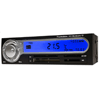
What’s a computer without a cool front panel? Thermaltake’s Hardcano is more than just a cool LED light. It allows you to control up to four fans and also keep track of four sensors. How well does it work? Read on…
Page 2 – Installation, Testing
When you first unpack the Hardcano 13, the sheer mess of the wires (fan control, temperature probes, and power cables) makes it seem like this installation is not going to be any walk in the park. Trying to make sense of that tangled mess certainly caused me a great deal of confusion at first, but after I cleared off some desk space and I paired the fan control wires with their temperature sensor counter-parts the installation became more and more clear. For best results the manual recommends that you pair up the wires so that the correct temperature will be displayed with the correct fan on the LED display.
After all the parts were organized the installation was fairly simple, just connect the fan control cable from the Hardcano to the wires from the computer’s fans. The temperature sensors were a bit more involved, placement of the probes themselves wasn’t hard but getting your fingers into those tight spaces to put the tape down securely was a bit of a challenge but nothing a little patience couldn’t solve.
Testing the Hardcano was very simple and it performed very well, I compared the Hardcano’s temperature readings to the readings from Lavalys Everest Ultimate edition monitoring software. Each of the Temperature readings from the program and the Hardcano were exactly the same. The only differences occurred when the temperatures fluctuated; the Hardcano would have an immediate result where it would take Everest a few seconds to catch up.
The alarm warning function of the Hardcano works very well, I deliberately set the alarm temperature to a very low setting and ran Super PI (to 32 million) and Prime 95 FFT torture test in order to increase the CPU temp enough to trigger the alarm.
This product lets you know if there is a problem in a hurry. As soon as the alarm temperature is exceeded the backlit display on the Hardcano turns and flashes red and the alarm’s audible warning system kicks in. the only thing I didn’t like about the alarm function is the limited number of temperature levels you only have four choices that you can set your alarm to; 40, 50, 60, or 70 degrees.
Using the memory card reader functions of the Hardcano 13 is as simple as using any other card reader. Connect the USB cord from the Hardcano to the USB connectors on your motherboard and you can start using the card readers.
Another convenient feature of the Hardcano is the fan speed adjuster. There are 2 settings on the Hardcano you can use to adjust your fan’s speeds, Automatic or Manual. When in the automatic setting the Hardcano will automatically adjust your fan speed when the temperature increases in order to maintain a stable operating temperature. In the manual setting the, user has complete control over the operating speeds of their fans, faster for better cooling or slow for more sound efficient operation.
The Thermaltake Hardcano 13 is a great product for anyone on air cooling looking to keep a close on their computer’s internal temperatures and have control over those temperatures with control over your fan speeds. The Hardcano also adds great looks to your high-end gaming rig and the buttons are slim enough to fit behind any case door. The only room for improvement I can see for this product is it does cause your case to become a little cluttered with wires and I found the price above other similar products. If you want one that will last the Hardcano is worth the extra cash.
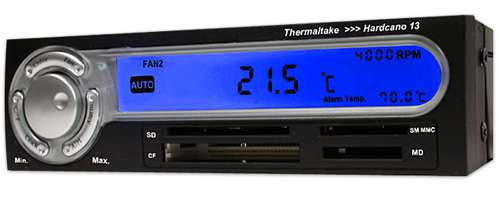
For its great functionality and its simplicity of use, I am giving the Thermaltake Hardcano 13 an 8 out of 10 on the Techgage scale.
If you wish to discuss our review, feel free to jump into the related thread. You do not need to register in order to reply to these threads.

Support our efforts! With ad revenue at an all-time low for written websites, we're relying more than ever on reader support to help us continue putting so much effort into this type of content. You can support us by becoming a Patron, or by using our Amazon shopping affiliate links listed through our articles. Thanks for your support!




